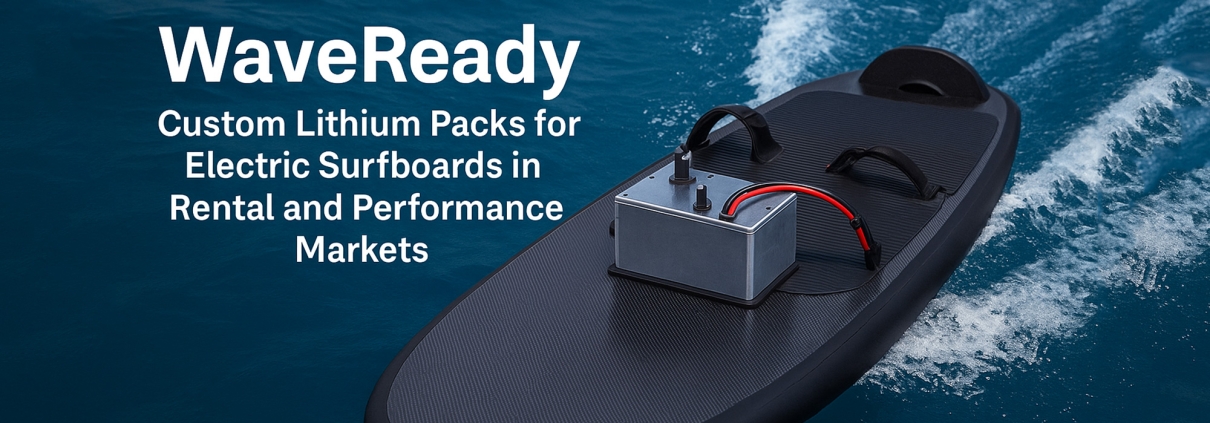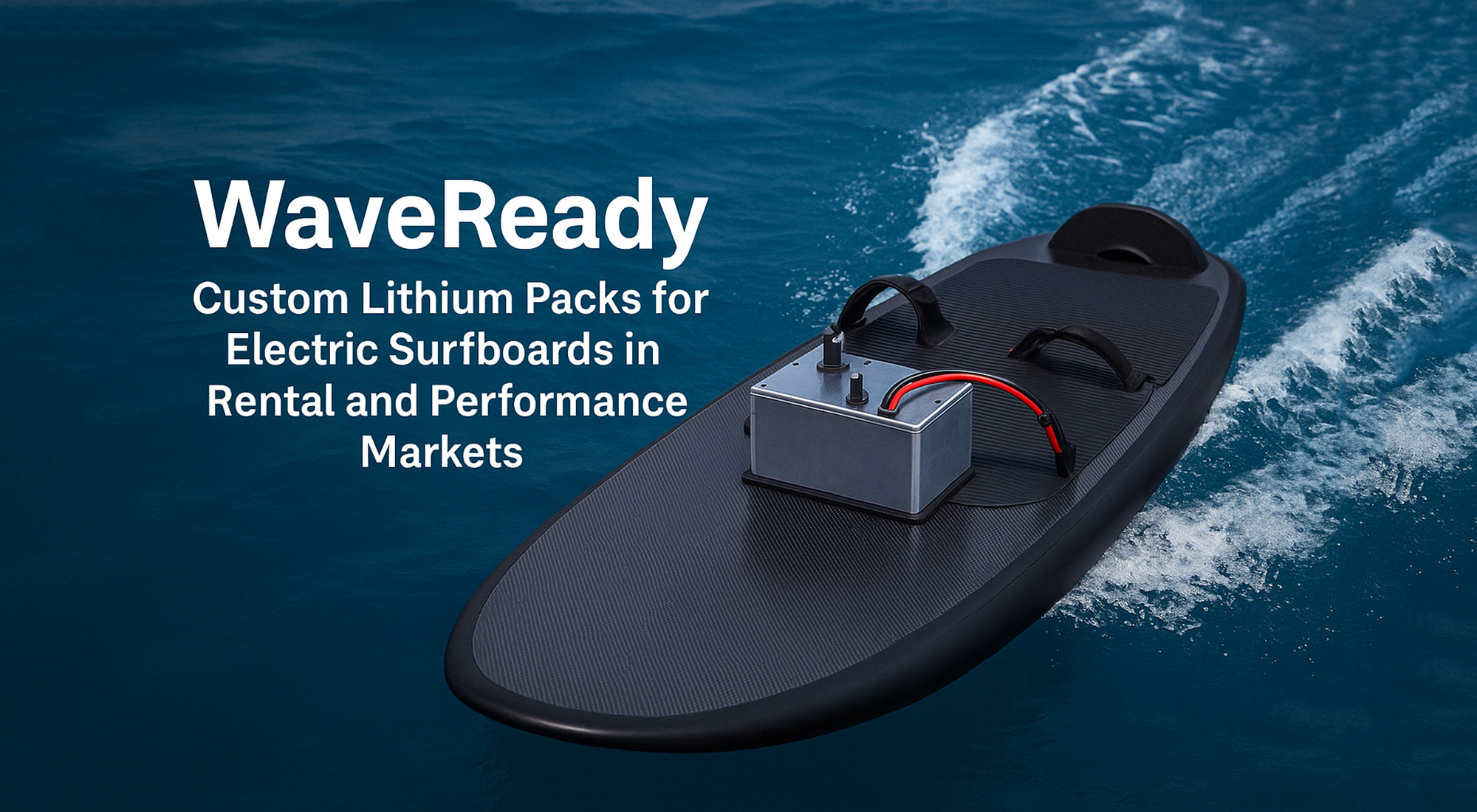WaveReady: Custom Lithium Packs for Electric Surfboards in Rental and Performance Markets
The advent of electric surfboards — boards that provide motor-driven surfing even without breaking waves — has transformed the watersports market. Whether in resorts, lakefronts, or coastal rental fleets, e-surfboards bring new excitement and accessibility to all skill levels. Central to delivering a safe, high-performance experience is the battery system — specifically, a custom lithium pack designed for the board’s dynamics, rental usage patterns, maintenance regime, and branding requirements.
This article provides a hands-on guide for surfboard manufacturers, rental operators, and service providers on custom lithium battery application in electric surfboards — what to look for, how to deploy, and how to ensure safety and business viability.
⚙️ Understanding the Electric Surfboard Use Case
Unlike traditional surfboards, electric surfboards integrate a motor, battery system, and often a remote throttle. A typical model houses a 3.1 kWh lithium-ion pack, dual motors, and delivers high-power surfing across flat water. In rental or resort setups, boards may see intense usage — multiple rides per day, rapid recharge or swap cycles, and exposure to saltwater and sun.
The battery system must be robust, serviceable, and aligned with rental business models. PKNERGY custom battery systems are engineered to meet these performance and operational needs.
🔋 Why Choose a Custom Lithium Pack for E-Surfboards
- 🏄♂️ Branding & differentiation: A proprietary battery pack allows surfboard OEMs to market “premium ride time”, “quick-swap module”, and “marine-safe lithium system”.
- 🔁 Rental-friendly design: Supports hot-swap systems, quick-release handles, onboard diagnostics, and telemetry for fleet management.
- ⚡ Performance-driven output: High power for acceleration, stable voltage under load, and fast throttle response enabled by custom BMS tuning.
- 🧰 Serviceability & lifecycle management: Long cycle life (up to 4,000 cycles), easy inspection, and integration with rental tracking systems.
🧩 Key Selection & Integration Considerations
- ⏱️ Ride time vs. recharge cycle: Balance between longer sessions and quick turnaround for rental fleets. Battery capacity impacts both performance and weight.
- ⚙️ Discharge rate and motor matching: Ensure peak current capability aligns with motor requirements; test for voltage stability under high load.
- 🔌 Modular swap design: Hot-swappable battery modules reduce downtime and improve utilization in rental environments.
- 📡 Smart monitoring and BMS: Include remote diagnostics, cycle counting, and temperature sensors to predict maintenance needs.
- 🌊 Environmental protection: Design with IP-rated sealing, corrosion resistance, and marine-grade connectors for durability.
- 📦 Transport & compliance: Batteries must meet UN38.3 standards for safe shipment and storage.
🚀 Operational Deployment Best Practices
- 🧭 Fleet management: Implement swap rotation policies, track battery health, and retire aged packs early.
- 👨🔧 Training & safety: Train staff to connect/disconnect safely and handle lithium systems in marine settings.
- ⚡ Charging infrastructure: Choose between centralized racks, portable chargers, or dockside quick-swap stations.
- 📊 Data capture: Log ride times, recharge cycles, and failure incidents for predictive maintenance.
- 💰 Lifecycle planning: Integrate depreciation and replacement costs into rental pricing to ensure ROI.
💼 Business Value & ROI
- ⏳ Maximize ride time: Longer sessions improve user satisfaction and rental yield.
- 🚤 Minimize downtime: Quick-swap packs enhance fleet utilization.
- 🧱 Reduce risk: Certified custom batteries ensure operator safety and regulatory compliance.
- 🏆 Differentiation: Promote “premium battery performance” as a selling point for both rental and retail markets.
- 💹 Lower total cost: Despite higher upfront cost, long life and low maintenance improve total cost of ownership.
⚠️ Challenges & Mitigation
- 💸 High upfront development cost: Offset through leasing or modular upgrade models.
- 🤿 Unpredictable usage patterns: Size batteries with safety margin and include usage tracking.
- 🌦️ Environmental stress: Saltwater and sun exposure demand marine-grade enclosures.
- 📦 Transport limitations: Ensure battery designs are certified and logistics-friendly for global distribution.
- 🔁 Technology evolution: Build modularity for future cell upgrades.
✅ Conclusion
In the electric surfboard market — particularly for rental fleets and high-performance models — the battery pack defines ride time, safety, and profitability.
By deploying a custom lithium system aligned with real-world usage, operators can achieve higher uptime, reliability, and user satisfaction.
PKNERGY’s marine-grade lithium packs combine innovation, safety, and performance to redefine the e-surfboard experience — transforming battery power into real surfing performance.
📩 Contact Information
Cassie | PKNERGY Energy Co., Ltd.
Email: sale4@pknergy.com
WhatsApp/Tel: +86 13974604556
🌐 Website: https://pknergypower.com





